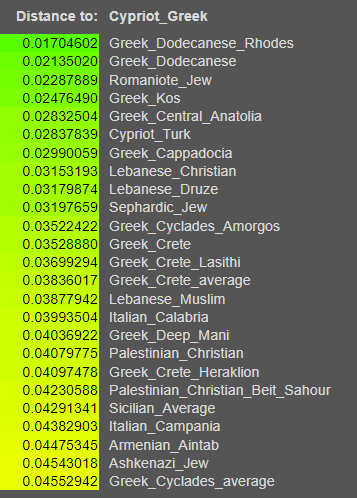Blog moved here: https://genesoftheancients.wordpress.com/
Click here to read more about the DNA of Greeks and Italians-> Ancient Greek ancestry in Greeks and Italians through G25 and qpAdm Analysis
This will be expanded and updated in the future
We lack extensive ancient DNA samples from Cyprus, except for low-coverage Neolithic and Chalcolithic data, which may not be relevant for this. Cypriots share genetic similarities with Roman-era Southern Greeks and West Anatolians, with an additional 25% Levantine admixture. The Anatolian like component in Cypriots aligns more with the Roman-era Aegean population from Southern Greece and West Anatolia than native iron age Central Anatolians, while modern Greek Central Anatolians primarily exhibit the Iron Age Central Anatolian type ancestry.
Modern Cypriot Greeks exhibit a stronger genetic similarity to Roman-era Southern Greeks than to modern Southern Greeks, primarily due to the Slavic and West Balkan admixture in modern mainland Greek populations. Cypriots are more similar genetically to Roman-era Southern Greeks and Dodecanese than to any other population today. After Roman-era Greeks and modern Aegean Greek islanders, Cypriots are also similar genetically to the Lebanese and Calabrians. Cypriots fall in the middle of the genetic spectrum/cline between the Calabrians and Lebanese.
While Southern Greeks today have approximately 25% Slavic admixture, Cypriots possess around 25% Levantine admixture. It's worth noting that Roman-era Southern Greeks shared a more significant genetic similarity with Levantines than with Slavs which is why modern Cypriots are still so similar to Roman-era Southern Greeks. Additionally, the modern Southern Greeks have Illyrian and Thracian admixture, possibly resulting from Thraco-Roman migrations during the late medieval and Ottoman periods. Roman-era Northern Greeks probably already had some Illyrian and Thracian admixture but there aren't any public DNA samples from post Bronze age Northern Greece yet.
The overall Bronze age Mycenaean admixture in Cyprus approximates 25%, which aligns with the levels observed in Crete and the Dodecanese. In contrast, mainland Greek Mycenaean admixture may be slightly lower due to the Slavic and Thraco-Roman migrations diluting Mycenaean admixture. The total Roman era (1-200AD) Greek ancestry in Cypriots is around 65% to 90% depending on if Roman era Cypriots had the same amount of excess Levantine, we are assuming that Cyprus had excess Levantine since then due to geographic proximity.
Nevertheless, the remaining admixture in all modern Greeks continues to exhibit similarities to that of their ancient Greek counterparts, owing to historical mixing with genetically similar neighboring populations. While we lack confirmed Dorian samples, it's reasonable to assume their genetic similarity to Illyrians due to their geographical proximity. Additionally, Thracians and ancient Anatolian DNA samples exhibit significant genetic resemblance to Mycenaean DNA samples.
G25 admixture chart comparing them to Roman era Greeks and Levantines:

Source populations: Balkan Thraco-Roman (Early Vlach and Early Albanian) vs Eastern Roman Aegean model:

Samples used: https://pastebin.com/eaLC1kED
Balkan Thraco-Roman (Early Vlach and Early Albanian) vs Eastern Roman Aegean model:

Samples used: https://pastebin.com/eaLC1kED
Closest modern populations genetically to Cypriots:
This is a G25 neolithic chart so keep in mind its not as accurate as qpAdm. I will remake this chart with qpAdm.



















